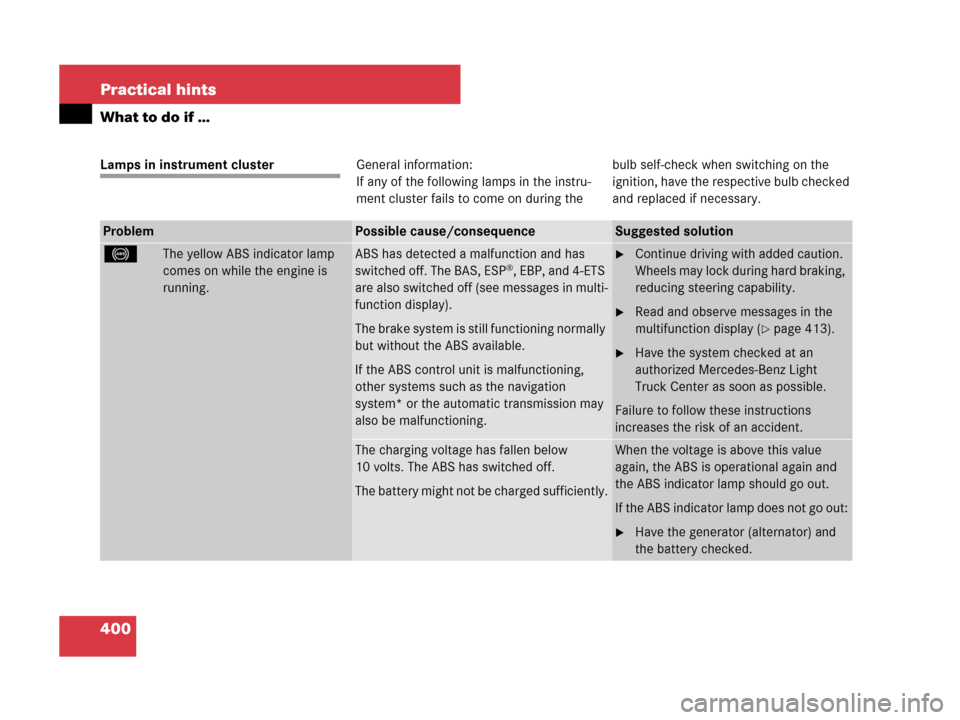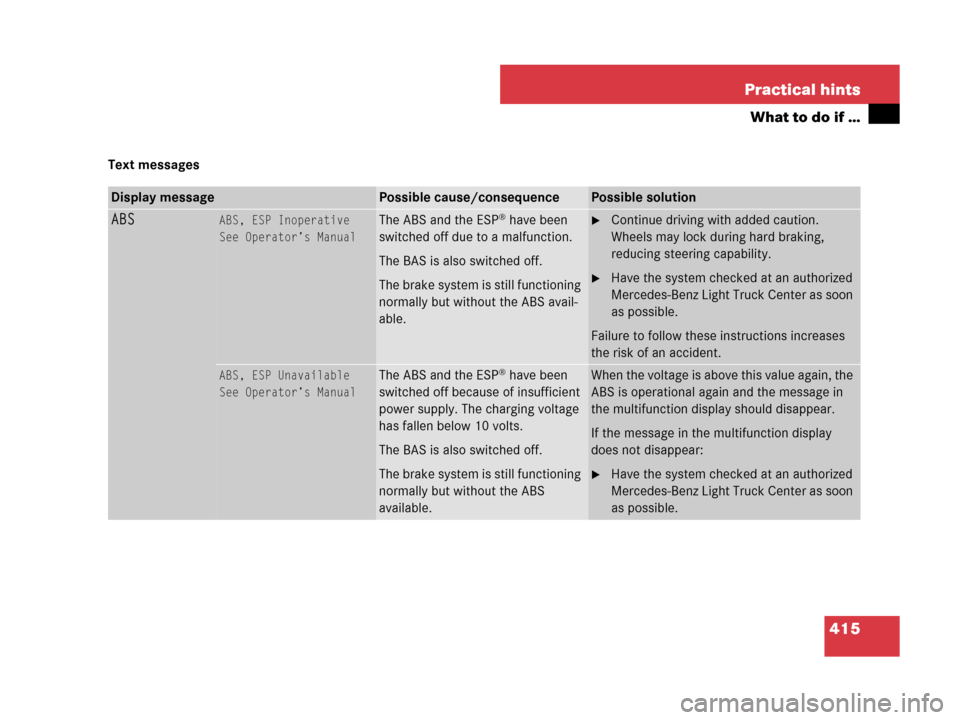Page 394 of 561

393 Operation
Vehicle care
�Shift the automatic transmission to
neutral positionN.
�Release the brake pedal.
�If engaged, release the parking brake
(
�page 57).
�Switch off the ignition and leave the
SmartKey with KEYLESS-GO* in the
starter switch.Ornamental moldings
For regular cleaning and care of ornamen-
tal moldings, use a damp cloth.Headlamps, brake lamps, tail lamps,
side markers, turn signal lenses
�Use a mild car wash detergent, such as
Mercedes-Benz approved Car Sham-
poo, with plenty of water.
iAfter running the vehicle through an auto-
matic car wash, wipe any wax off of the wind-
shield (
�page 395). This will prevent smears
and reduce wiping noise which can be caused by
residual wax on the windshield.
When leaving the car wash, make sure that the
mirrors are folded out. Otherwise they may
vibrate.
!Do not use chrome cleaner on ornamental
moldings. Although ornamental moldings may
have chrome appearance, they could be made of
anodized aluminum that will be damaged when
cleaned with chrome cleaner. Instead, use a
damp cloth to clean those ornamental moldings.
For very dirty ornamental moldings of which you
are sure are chrome-plated, use a chrome clean-
er. If in doubt whether an ornamental molding is
chrome-plated, contact an authorized
Mercedes-Benz Light Truck Center.
!Only use window cleaning solutions that are
suitable for plastic lamp lenses. Window clean-
ing solutions which are not suitable may damage
the plastic lamp lenses of the headlamps. There-
fore, do not use abrasives, solvents or cleaners
that contain solvents.
Never apply strong force and only use a soft,
non-scratching cloth when cleaning the lenses.
Do not attempt to wipe dirty lenses with a dry
cloth or sponge.
Otherwise you may scratch or damage the lens
surface.
Page 397 of 561

396 Operation
Vehicle care
Light alloy wheels
If possible, clean wheels once a week.
�Use Mercedes-Benz approved Wheel
Care, a soft bristle brush and a strong
spray of water for cleaning the light al-
loy wheels.Plastic and rubber parts
�Use a gentle dishwashing detergent or
mild detergent for delicate fabrics as a
washing solution.
�Wipe with a cloth moistened in a
lukewarm solution.
The surface may temporarily change
color. If this is the case, wait for it to
dry.Hard plastic trim items
�Use Mercedes-Benz approved Interior
Care, a soft, lint-free cloth and apply
with light pressure.
!Only use acid-free cleaning materials. Acid
may cause corrosion or damage the clear coat.
!The vehicle should not be parked for an ex-
tended period of time immediately after it has
been cleaned, especially not after the wheel rims
have been cleaned with wheel rim cleaner.
Wheel rim cleaners can lead to increased
corrosion of the brake disks and brake pads.
Non-approved wheel cleaners may also damage
the wheel paint if the car is not driven after
cleaning. Therefore, the vehicle’s brake system
should always be warmed-up before it is parked
after cleaning. To do so, please drive your vehicle
for several minutes to allow the brakes to dry.
When applying Mercedes-Benz approved Tire
Care and Mercedes-Benz approved Wheel Care
products, take care not to spray them on the
brake disks.
Warning!G
Do not use cleaners or cockpit care sprays
containing solvents to clean the cockpit or
the steering wheel. Cleaners containing sol-
vents will make the surface porous and vehi-
cle occupants could suffer serious injuries
from plastic parts coming loose in the event
of air bag deployment.
!Do not use oil, wax or scouring agents on
these parts.
Never apply strong force and only use a soft,
non-scratching cloth when cleaning the surface.
Do not attempt to wipe the surface with a dry
cloth or sponge.
Otherwise you may scratch or damage the
surface.
!Never apply strong force and only use a soft,
non-scratching cloth when cleaning the surface.
Do not attempt to wipe the surface with a dry
cloth or sponge.
Otherwise you may scratch or damage the
surface.
Page 401 of 561

400 Practical hints
What to do if …
Lamps in instrument clusterGeneral information:
If any of the following lamps in the instru-
ment cluster fails to come on during thebulb self-check when switching on the
ignition, have the respective bulb checked
and replaced if necessary.
ProblemPossible cause/consequenceSuggested solution
-The yellow ABS indicator lamp
comes on while the engine is
running.ABS has detected a malfunction and has
switched off. The BAS, ESP®, EBP, and 4-ETS
are also switched off (see messages in multi-
function display).
The brake system is still functioning normally
but without the ABS available.
If the ABS control unit is malfunctioning,
other systems such as the navigation
system* or the automatic transmission may
also be malfunctioning.
�Continue driving with added caution.
Wheels may lock during hard braking,
reducing steering capability.
�Read and observe messages in the
multifunction display (
�page 413).
�Have the system checked at an
authorized Mercedes-Benz Light
Truck Center as soon as possible.
Failure to follow these instructions
increases the risk of an accident.
The charging voltage has fallen below
10 volts. The ABS has switched off.
The battery might not be charged sufficiently.When the voltage is above this value
again, the ABS is operational again and
the ABS indicator lamp should go out.
If the ABS indicator lamp does not go out:
�Have the generator (alternator) and
the battery checked.
Page 402 of 561

401 Practical hints
What to do if …
ProblemPossible cause/conse-
quenceSuggested solution
-The yellow ABS indicator lamp comes on while
the engine is running.The self-diagnosis has not yet
been completed yet.The display will clear after driving a short
distance at a vehicle speed of above
12 mph (20 km/h).
;(USA only)
3(Canada only)
The red brake warning lamp
comes on while driving and an
acoustic warning sounds.You are driving with the
parking brake set.�Release the parking brake
(
�page 57).
There is insufficient brake fluid
in the reservoir.�Risk of accident! Carefully stop the
vehicle in a safe location or as soon as
it is safe to do so.
�Apply the parking brake (�page 65).
�Contact an authorized
Mercedes-Benz Light Truck Center.
Do not add brake fluid! This will not
solve the problem.
Warning!G
Driving with the brake warning lamp illumi-
nated can result in an accident. Have your
brake system checked immediately if the
brake warning lamp stays on.
Do not add brake fluid before checking the
brake system. Overfilling the brake fluid res-
ervoir can result in spilling brake fluid on hot
engine parts and the brake fluid catching
fire. You can be seriously burned.!If you find that the brake fluid in the brake
fluid reservoir has fallen to the minimum mark or
below, have the brake system checked for brake
pad thickness and leaks.
Page 403 of 561
402 Practical hints
What to do if …
ProblemPossible cause/conse-
quenceSuggested solution
;(USA only)
3(Canada only)
-
v
The red brake warning lamp
comes on while driving. In
addition, the yellow ABS mal-
function indicator lamp, and
the yellow ESP
® warning lamp
come on and an acoustic warn-
ing sounds.
The Electronic Brake Propor-
tioning (EBP) has switched off
due to a malfunction.
The ABS, the BAS, and the
ESP
® are also switched off.
�Have the system checked at an autho-
rized Mercedes-Benz Light Truck
Center as soon as possible.
Failure to follow these instructions
increases the risk of an accident.
Page 404 of 561

403 Practical hints
What to do if …
ProblemPossible cause/consequenceSuggested solution
?(USA only)
±(Canada only)
The yellow engine malfunc-
tion indicator lamp comes on
while driving.There is a malfunction in:
�The fuel management system
�The ignition system
�The emission control system
�Systems which affect
emissions
Such malfunctions may result in
excessive emissions values and
may switch the engine to its
limp-home (emergency opera-
tion) mode.
�Have the vehicle checked as soon as
possible by an authorized
Mercedes-Benz Light Truck Center.
An on-board diagnostic connector is
used by the service station to link the
vehicle to the shop diagnostics
system. It allows the accurate identi-
fication of system malfunctions
through the readout of diagnostic
trouble codes. It is located in the
front left area of the footwell next to
the parking brake pedal.
iSome states may by law require you to visit
a workshop as soon as the engine malfunction
indicator lamp comes on. Check local require-
ments.
Page 416 of 561

415 Practical hints
What to do if …
Text messages
Display messagePossible cause/consequencePossible solution
ABSABS, ESP Inoperative
See Operator’s ManualThe ABS and the ESP® have been
switched off due to a malfunction.
The BAS is also switched off.
The brake system is still functioning
normally but without the ABS avail-
able.�Continue driving with added caution.
Wheels may lock during hard braking,
reducing steering capability.
�Have the system checked at an authorized
Mercedes-Benz Light Truck Center as soon
as possible.
Failure to follow these instructions increases
the risk of an accident.
ABS, ESP Unavailable
See Operator’s ManualThe ABS and the ESP® have been
switched off because of insufficient
power supply. The charging voltage
has fallen below 10 volts.
The BAS is also switched off.
The brake system is still functioning
normally but without the ABS
available.When the voltage is above this value again, the
ABS is operational again and the message in
the multifunction display should disappear.
If the message in the multifunction display
does not disappear:
�Have the system checked at an authorized
Mercedes-Benz Light Truck Center as soon
as possible.
Page 417 of 561
416 Practical hints
What to do if …
Display messagePossible cause/consequencePossible solution
ABSUnavailable
See Operator’s ManualThe self-diagnosis has not yet been
completed yet.The display will clear after driving a
short distance at a vehicle speed of
above 12 mph (20 km/h).
Cruise Control And
SPEEDTRONICInoperativeThe cruise control is malfunctioning.�Have cruise control checked by an
authorized Mercedes-Benz Light
Truck Center.
Cruise Control––– MPHYou have attempted to set a speed
while driving below 20 mph
(30 km/h).�Accelerate to a speed exceeding
20 mph (30 km/h) and set the
speed (
�page 244).
The ESP® is switched off.�Switch on the ESP® (�page 100).
The automatic transmission is set to
positionP, R, orN.�Set the automatic transmission to
positionD (
�page 185).
The vehicle is secured with the
parking brake.�Release the parking brake
(
�page 57).